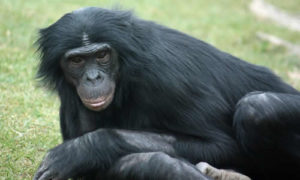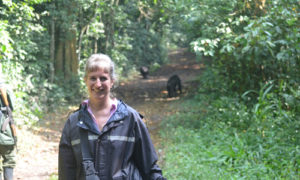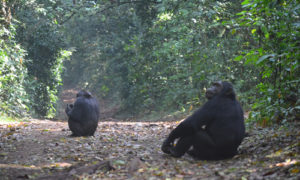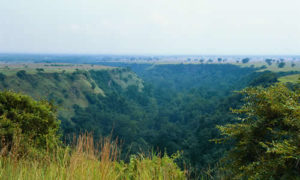Chimpanzee trekking in Uganda takes you to the pearl of Africa for an amazing encounter with man’s closest relative. Chimpanzees belong to the family of great apes that include gorillas and orangutans. Because of their close relationship to humans, they have large brains and are very intelligent with great ability to learn new things. Studies by great primatologists like Jane Goodall have even shown unique cultures among different communities based on their specific diets and habitats.
There are two distinct species of chimpanzee remaining in the wild – The common chimpanzee and the pygmy chimpanzee (known as Bonobo). The common chimpanzees are found in West, East, Central and Southern Africa while the Bonobos are only found in Congo’s jungles and sanctuaries. The common chimpanzee is larger (weighing up to 70kgs), more aggressive with communities led by a dominant male. Bonobos are smaller, more peaceful/gentile with communities led by female leaders. Both species can live up to 30 years in the wild and 60 in captivity.  Because of their relative intelligence, chimpanzees are capable of constructing complex nests and using tools like rocks for opening nuts or sticks for removing termites from anthills. Chimps live off fruit, seeds, tree leaves, honey and insects. Chimpanzees also eat meat from other mammals and primates whenever they can.
Because of their relative intelligence, chimpanzees are capable of constructing complex nests and using tools like rocks for opening nuts or sticks for removing termites from anthills. Chimps live off fruit, seeds, tree leaves, honey and insects. Chimpanzees also eat meat from other mammals and primates whenever they can.
Chimpanzees live in large extended families/communities of between 10 – 100 individuals that look out for and take care of each other. Unlike Mountain gorillas and baboons, these large communities often split into smaller groups while heading out for feeding before getting back together again. The males stay within the community while the females may leave for nearby communities once they reach adolescence. The young reach independence at 4 years. Like humans, they use complex methods that include facial expressions, gestures, sounds and body language to interact, communicate and convey emotion.
 Though widely spread in Africa, the overall population of chimpanzees have reduced drastically in the last two decades with the result that they are now declared a critically endangered species. The main threat to chimps comes from disease, hunting (for meat and trade), injuries from forest traps and the destruction of habitat due to increasing human populations. However several organizations have been formed to protect the remaining chimpanzee population and ensure that they remain surviving in the wild. One such organization is The Jane Goodall Foundation which plays a great role in the conservation of chimpanzee and other primates including mountain gorillas throughout Africa. You can read more about chimpanzee trekking in Tanzania.
Though widely spread in Africa, the overall population of chimpanzees have reduced drastically in the last two decades with the result that they are now declared a critically endangered species. The main threat to chimps comes from disease, hunting (for meat and trade), injuries from forest traps and the destruction of habitat due to increasing human populations. However several organizations have been formed to protect the remaining chimpanzee population and ensure that they remain surviving in the wild. One such organization is The Jane Goodall Foundation which plays a great role in the conservation of chimpanzee and other primates including mountain gorillas throughout Africa. You can read more about chimpanzee trekking in Tanzania.
Chimpanzee trekking in Uganda
![]() Uganda offers arguably the best places to track chimpanzee in the world. It has one of the largest population and variety of places to track chimpanzees – over 5600 chimpanzee in the wild with a sizeable number of communities habituated. Uganda’s chimps can even be found living in small forests on private land in some areas. Chimpanzees in Uganda can be tracked from Kibale National Park, Budongo forest (in Murchison Falls National Park), Kyambura Gorge (Queen Elizabeth National Park), Kalinzu Forest and Toro-Semliki Wildlife Reserve. Visitors can also spot chimpanzee in zoos and sanctuaries like Ngamba Island Chimpanzee Sanctuary and Uganda Wildlife Education Center
Uganda offers arguably the best places to track chimpanzee in the world. It has one of the largest population and variety of places to track chimpanzees – over 5600 chimpanzee in the wild with a sizeable number of communities habituated. Uganda’s chimps can even be found living in small forests on private land in some areas. Chimpanzees in Uganda can be tracked from Kibale National Park, Budongo forest (in Murchison Falls National Park), Kyambura Gorge (Queen Elizabeth National Park), Kalinzu Forest and Toro-Semliki Wildlife Reserve. Visitors can also spot chimpanzee in zoos and sanctuaries like Ngamba Island Chimpanzee Sanctuary and Uganda Wildlife Education Center
Kibale Forest: The best place to track chimpanzees in East Africa is in Kibale forest. The forest is a hub for several species of primates and has a chimpanzee population numbering 1500 – That is to say 30 percent of the overall chimp population in Uganda. There are 3 habituated communities across Kibale National Park. One community has been set apart for tourists while the other two are for researchers.  Apart from chimpanzees, there are several primate species that call Kibale forest home among which include the L’Hoests monkey, Red colobus, Mangabeys, bush babys, baboons, Red tailed monkeys and the blue monkeys to mention but a few. Tracking chimps in Kibale can also go hand in hand with birding tours and other wildlife viewing. Some of the wildlife that can be spotted while tracking chimps in the forest includes Buffaloes, elephants, antelopes, bush pigs, otters and giant forest hogs. Birders will be impressed with the over 345 species in the forest and the nearby Bigodi Wetlands bird sanctuary like the African grey parrot, hornbills and Breasted pitas. For the best primates experience in Kibale, check out this 3 Days Chimpanzee tracking tour in Kibale Forest National Park.
Apart from chimpanzees, there are several primate species that call Kibale forest home among which include the L’Hoests monkey, Red colobus, Mangabeys, bush babys, baboons, Red tailed monkeys and the blue monkeys to mention but a few. Tracking chimps in Kibale can also go hand in hand with birding tours and other wildlife viewing. Some of the wildlife that can be spotted while tracking chimps in the forest includes Buffaloes, elephants, antelopes, bush pigs, otters and giant forest hogs. Birders will be impressed with the over 345 species in the forest and the nearby Bigodi Wetlands bird sanctuary like the African grey parrot, hornbills and Breasted pitas. For the best primates experience in Kibale, check out this 3 Days Chimpanzee tracking tour in Kibale Forest National Park.
Chimpanzee tracking in Kibale forest is done twice a day – in the morning at 8am and in the afternoon at 2pm. The chances of seeing a chimpanzee community in Kibale is very high at over 90 percent. Visitors to Kibale Forest also have a chance to experience full day chimpanzee habituation with one of the chimpanzee communities. Permits from tracking chimpanzee in Kibale Forest are more expensive than any other place in Uganda at $250. Chimpanzee habituation permits will cost one $300. For those who are organizing their trip by themselves, the permits can be acquired by emailing or calling staff from the Uganda Wildlife Authority office – try to book in advance. There are some discounts during certain months of the year. If you are booked with Mission Africa Safaris, the company will help you arrange for everything including securing the permit.
Kalinzu Forest: After Kibale, Kalinzu Forest located outside Queen Elizabeth National park is arguably the second best place to track chimpanzee in Uganda. Visitors to the Queen Elizabeth national park often end up going to the park’s Kyambura Gorge but the probability of seeing chimpanzee is higher in Kalinzu forest. The sheer density and concentration of chimps in a relatively small area raises the possibility of finding them to over 90 percent. Apart from chimps, visitors should expect to spot over 410 bird species, primates, butterflies, moths, reptiles and flowers as they pass through the four guided trails in the forest. ![]() Some of the bird species include the sunbird, cuckoos and the Great Blue Turaco.
Some of the bird species include the sunbird, cuckoos and the Great Blue Turaco.
There are about 290 chimps found in Kalinzu forest with over 70 habituated. A group of Japanese scientists have been studying chimpanzee communities here for the last two decades. Chimpanzee trekking in Kalinzu forest is managed by the Uganda ministry of forestry. Because of different management, a chimpanzee tracking permit costs $50 which is far less than at Kibale. Moreover, the minimum age for tracking chimpanzees is 12 years in Kalinzu forest. One disadvantage of tracking chimps here is that there is no good accommodation in the forest except for night camps. Visitors have to go back to get proper accommodation near the Queen Elizabeth national park.
Budongo Forest: With an area of about 825 square kilometers and a population of over 800 chimpanzees, Budongo forest is the third best place to track chimpanzees in Uganda. Budongo forest is found within the Murchison falls national park – reaching the park takes 3 hours of driving from Kampala. The natural mahogany trees found in the forest provides perfect shelter for these amazing apes and other primates. About 100 habituated chimpanzees are available for tracking at Kaniyo Pabibi out of the total chimp population. Visitors who want to learn more about the chimpanzees can opt for the whole day chimpanzee habituation Experience in Budongo.
Chimpanzee tracking in Budongo starts at 7 am for the morning session and 2 pm for the afternoon session. The best time to track chimpanzee in Budongo is between the months of May and August which are rainy seasons. During the dry season, the chimps move deep into the forest looking for scarce food, water and shelter. This movement reduces the chances of seeing them significantly because trackers have to move great distances looking for them. Chimpanzee trekking in Budongo can be arranged alongside a wildlife safari to the Murchison falls national park. Chimpanzee permits cost $130 in Budongo.
Kyambura Gorge: Located in a valley within the Queen Elizabeth National Park, the Kyambura gorge is a convenient place to spot chimpanzee while on a safari to Queen Elizabeth National Park. The gorge is 16km long and about 100 meters deep with a thick underground forest. The Kyambura Gorge is famous for its large concentration of primates like Baboons, red-tailed monkeys, vervet monkeys and colobus monkeys. The population of chimpanzees here is quiet small at about 30 but chimp trekking in Kyambura Gorge has two advantages. It is located within Uganda’s most visited national park and is one of the places where the park animals gather to drink offering a chance to see other primates and Africa’s largest mammals.  Tracking chimpanzee at Kyambura Gorge provides a visitor with a rare opportunity to go for a full safari combining chimpanzee trekking with birding, a game drive to queen Elizabeth National park and gorilla tracking at the nearby Bwindi impenetrable national park. Some of the bird species found at the Kyambura Gorge include the blue-headed bee-eater, falcons and the African Finfoot. One disadvantage of tracking chimpanzee at the Kyambura Gorge is that the probability of seeing them is low compare to Kibale or Kalinzu. The small chimpanzee community often move deep into the underground forest making it harder to find them on certain days. A chimpanzee permit costs $80 at the Kyambura gorge.
Tracking chimpanzee at Kyambura Gorge provides a visitor with a rare opportunity to go for a full safari combining chimpanzee trekking with birding, a game drive to queen Elizabeth National park and gorilla tracking at the nearby Bwindi impenetrable national park. Some of the bird species found at the Kyambura Gorge include the blue-headed bee-eater, falcons and the African Finfoot. One disadvantage of tracking chimpanzee at the Kyambura Gorge is that the probability of seeing them is low compare to Kibale or Kalinzu. The small chimpanzee community often move deep into the underground forest making it harder to find them on certain days. A chimpanzee permit costs $80 at the Kyambura gorge.
Semuliki Wildlife Reserve: Semuliki Wildlife Reserve is located near the border between Uganda and DR Congo and has a population of about 260 chimps living in 3 communities. The chimps are being studied by scientist from the Indiana University and have been found to have a unique habit of moving upright as they leave the forest to go feed in the Savannah.
Ngamba Island: This is a small but forested island on Lake Victoria which was turned into a chimpanzee sanctuary for rescued chimps all over Uganda. There are over 40 chimpanzees being cared for in the island. Ngamba Island is not designed for standard chimp tracking. Visitors and families with children are allowed to see the chimps from a secure raised platform as they come to feed three times a day.
The Uganda Wildlife Education Center: Formerly known as Entebbe Zoo, was established in 1952 to rehabilitate injured, confiscated and orphaned animals. About 40 chimpanzees can be seen here from enclosures by tourists and families with children.
Chimpanzee trekking in Rwanda
In Rwanda, Chimpanzee tracking is possible in Nyungwe forest and Gishwati-Mukura National Park. Mountain gorillas may be the most valuable tourism resource for Rwanda but chimpanzee trekking in Nyungwe forest national park is one adventurous activity that all primate lovers should take into consideration while visiting. A Chimpanzee permit in Rwanda costs only $100 compared to $1500 for gorilla trekking. Although Chimpanzee tracking is the most popular activity in Nyungwe forest, visitors should expect to come across over 10 species of primates which include L’Hoest’s , vervet monkeys, Angola colobus, Rwenzori colobus, owl-faced monkeys, Den’t mona monkeys, silver monkeys, golden monkeys, bush bay, olive baboons, red-tailed monkeys and grey-cheeked mangabey.
There are about 500 chimpanzees in Nyungwe forest but unfortunately most of them are not habituated. Finding the chimps is hard as they are always on the move in a large forest. Chimp trekking in Rwanda is usually done in Cyamudongo and Uwinka. Permits can be secured from the Rwanda Development Board offices in Kigali and at the park.
Comparing chimpanzee tracking and gorilla trekking
There are similarities and differences in the experiences of tracking these two great apes. One thing to first note is that Mountain gorillas are only found Uganda, Rwanda and DR Congo while Chimpanzee communities can be found in a sizeable number of countries in East, Central and West Africa. You can read more in this article about chimpanzee trekking and gorilla trekking.
gorilla trekking is far more organized than chimpanzee trekking and hence the chances of seeing mountain gorillas are very high – Almost guaranteed. That cannot be said of chimpanzees.
Chimpanzees live in relatively flatter terrain while mountain gorillas live in mountainous areas and slopes which can be stressful.
Chimpanzees spend most of their time on tree tops while gorillas spend their time on the ground.
Chimpanzees are mobile and always on the move requiring trackers to follow them constantly and at high pace whereas mountain gorillas tend to relax on the ground in a forest clearing – This can actually be exciting and adventurous for many.
The constant movements and habit of swinging from tree to tree makes it harder to take good photos of chimps.
Chimpanzees are very noisy during tracking while mountain gorillas usually feed and play quietly.
Finding the Chimpanzee community doesn’t take as long as locating a gorilla group.
Trekking can be done in two sessions per day – In the morning and afternoon. Gorilla tracking can only be arranged for one session in a day.
Chimpanzees live in large communities that frequently breakup into smaller parties to go looking for scarce food before getting back together again. Trackers often split up to follow these splinter groups which can lead to confusion if the chimps lead them back to the main group. Mountain gorillas live in a relatively stable group with plenty of food.
There is a one hour limit to how much time you can spend watching a mountain gorilla group. However visitors can spend more time with a chimpanzee community depending on which place and country they choose to go tracking.
Only 8 people can see a gorilla family in a day while 6 people can see a chimpanzee community in two daily shifts.
Chimpanzee and gorilla tracking are similar in that you need permits to take part in both activities. However gorilla permits cost much more than chimpanzee permits
There is an age limit requirement for visitors planning to take part in both chimpanzee and gorilla trekking – Usually 15 years and above.
For both experiences, you are advised to move with suitable clothing (boots, gloves, long shirts, rain jackets) and might require hiring a porter.
Rules, Requirements and Regulations for chimpanzee trekking in Uganda
Just like with mountain gorillas, tracking chimpanzee requires following some rules. You need to know the following.
- Book your chimpanzee permit in advance especially during the peak seasons.
- Children aren’t allowed to track chimpanzee.
- Do not litter the forest while tracking chimpanzee.
- It is not recommended to track chimpanzee while suffering from flue and diarrhea. Chimps are susceptible to human diseases.
- Keep a distance of about 8 meters while near the Chimpanzees.
- Do not eat while near the chimpanzees. They may come and grab it from you violently.
- Do not talk too loud, make fun of or try to intimidate/provoke chimpanzees.
- Taking photos using flash is not allowed.
- Always follow instructions from the forest guides.
- Try to visit the bathroom before heading out for trekking.
- Do not head out tracking without a guide.
- Smoking while tracking chimps isn’t allowed.
- There is a limit to how many people can track a chimpanzee community in a day.
Gear and equipment for chimpanzee tracking in Uganda
Chimpanzee trekking in Uganda requires careful planning with your tour company beforehand in order to make it a comfortable, memorable and stress-free event. To that end, you will need to think about bringing along the following:-
- Suitable Shoes: with good grip that is good for navigating through muddy terrain and steep areas.
- The right clothing: Long sleeved clothes that can help protect you from sharp thickets. Plan for the unpredictable weather and a rain jacket just in case.
- Packed snack and drinking water: This is just in case you get hungry or thirsty along the way.
- Binoculars: You don’t want to miss some of the details. These mighty apes love swinging from tree to tree.
- Insect repellent: Come with insect repellent.
- Camera and extra batteries: Taking photos of chimpanzees needs some preparation as they live in dense forest and are very quick in movement. Come with a good camera that has sharp lenses as the chimps live in long trees. Taking flash photos is prohibited.
- Binoculars: To spot the chimps and beautiful birds on top of the trees.
- Walking stick: Walking sticks will help you steadily navigate through steep and rough terrain.
- Porters: Porters can be hired from many of the parks and reserves to help carry heavy equipment and bags so that you concentrate on looking out for the chimps and other creatures.

